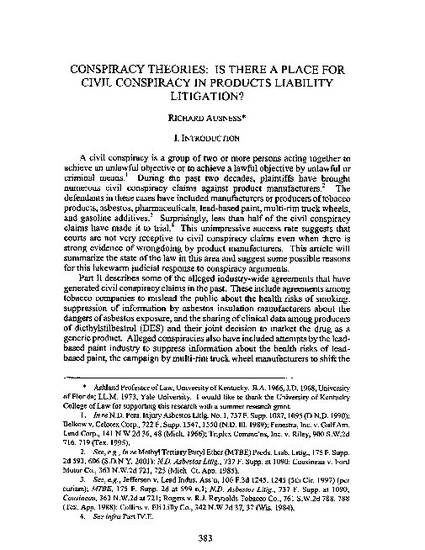
A civil conspiracy is a group of two or more persons acting together to achieve an unlawful objective or to achieve a lawful objective by unlawful or criminal means. During the past two decades, plaintiffs have brought numerous civil conspiracy claims against product manufacturers. The defendants in these cases have included manufacturers or producers of tobacco products, asbestos, pharmaceuticals, lead-based paint, multi-rim truck wheels, and gasoline additives. Surprisingly, less than half of the civil conspiracy claims have made it to trial. This unimpressive success rate suggests that courts are not very receptive to civil conspiracy claims even when there is strong evidence of wrongdoing by product manufacturers. This article will summarize the state of the law in this area and suggest some possible reasons for this lukewarm judicial response to conspiracy arguments.
Part II describes some of the alleged industry-wide agreements that have generated civil conspiracy claims in the past. These include agreements among tobacco companies to mislead the public about the health risks of smoking, suppression of information by asbestos insulation manufacturers about the dangers of asbestos exposure, and the sharing of clinical data among producers of diethylstilbestrol (DES) and their joint decision to market the drug as a generic product. Alleged conspiracies also have included attempts by the lead-based paint industry to suppress information about the health risks of lead-based paint, the campaign by multi-rim truck wheel manufacturers to shift the duty to warn about safety risks to employers, and the effort by the manufacturers of the gasoline additive methyl tertiary butyl ether (MTBE) to mislead the Environmental Protection Agency (EPA) about the dangers of ground water contamination with this product.
Part III examines the elements of civil conspiracy, including the agreement requirement and the overt act or independent tort requirement. It also identifies some other collective liability theories, such as "true conspiracy," concert of action, aiding and abetting, alternative liability, enterprise liability, and market share liability.
Part IV discusses some of the issues that have arisen in products liability litigation. This section examines issues associated with the agreement requirement, including unlawful purpose, parallel conduct, and membership in a trade association. The independent tort requirement is covered along with the various torts that have been proposed to support a civil conspiracy claim. Part IV also looks at the effect of civil conspiracy on statutes of limitation and repose and considers the right to the freedoms of expression and association as possible defenses to civil conspiracy claims.
Part V discusses some civil conspiracy concerns and suggests that they may explain why many courts have not been receptive to conspiracy theories. One explanation is that courts might generally disapprove of collective liability because it undermines the principle that there must be a causal relationship between a wrongdoer and the injured party. Another possible explanation is that courts fear massive tort liability will cause manufacturers to overinvest in accident cost avoidance or to withdraw useful products from the market. Courts have also been reluctant to intrude upon defendants' First Amendment rights of free expression and association. Finally, courts might dislike civil conspiracy claims because they often involve issues that other branches of government traditionally address.

Tennessee Law Review, Vol. 74, No. 3 (Spring 2007), pp. 383-420